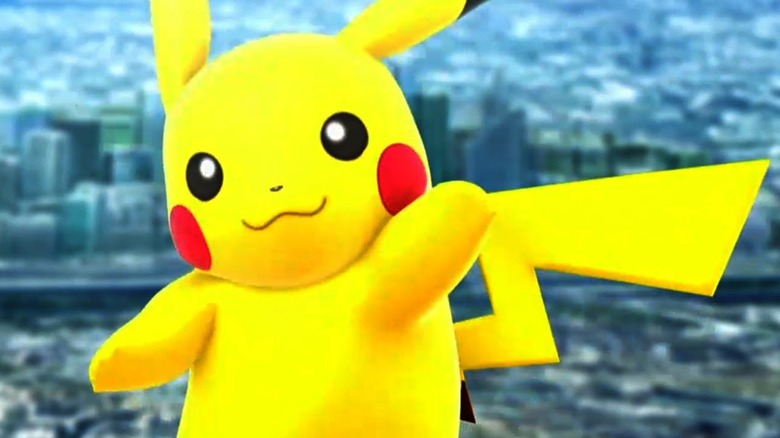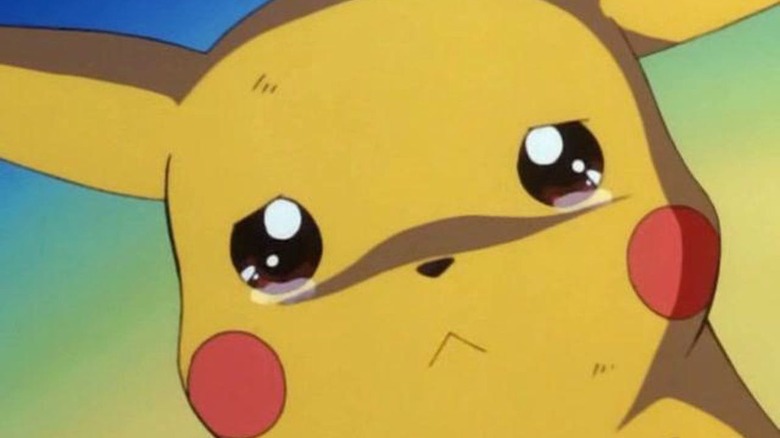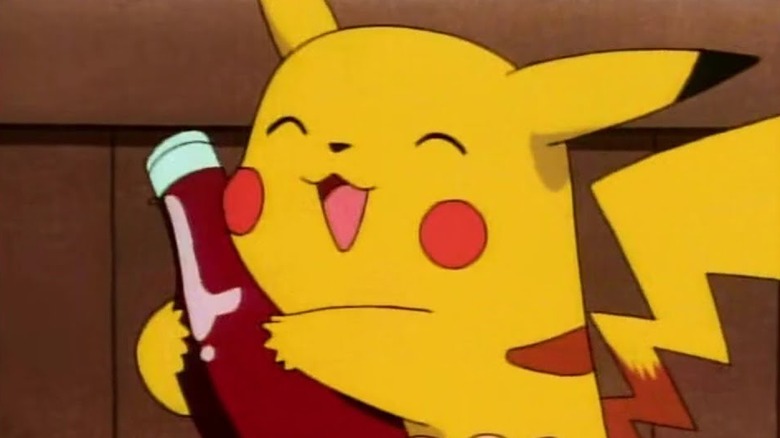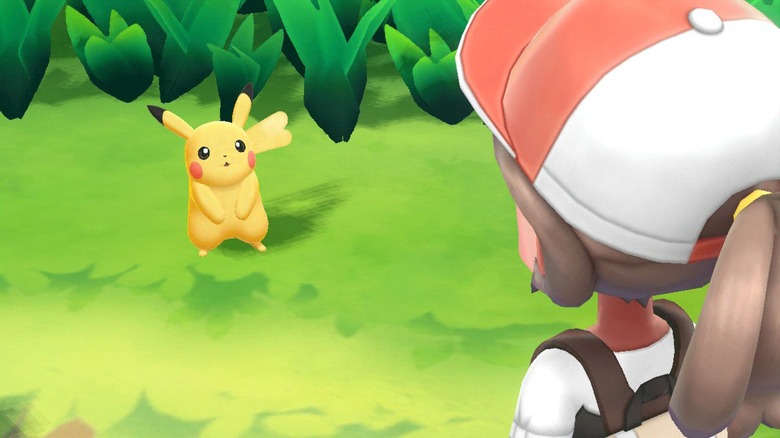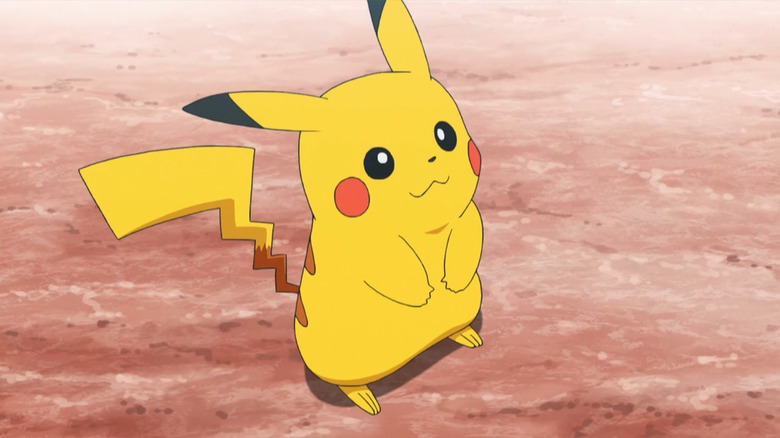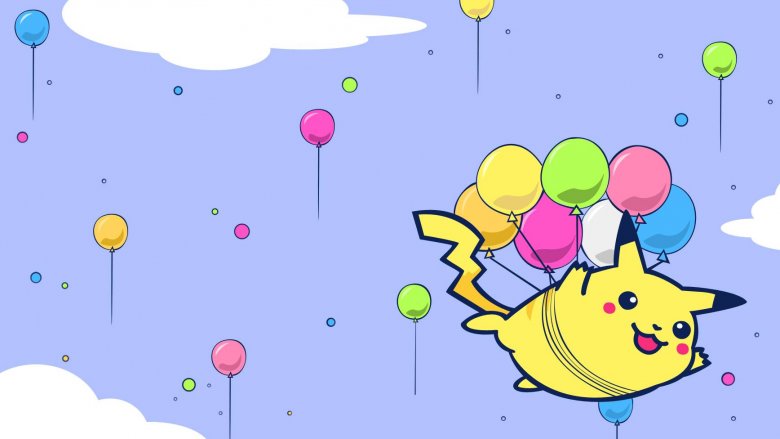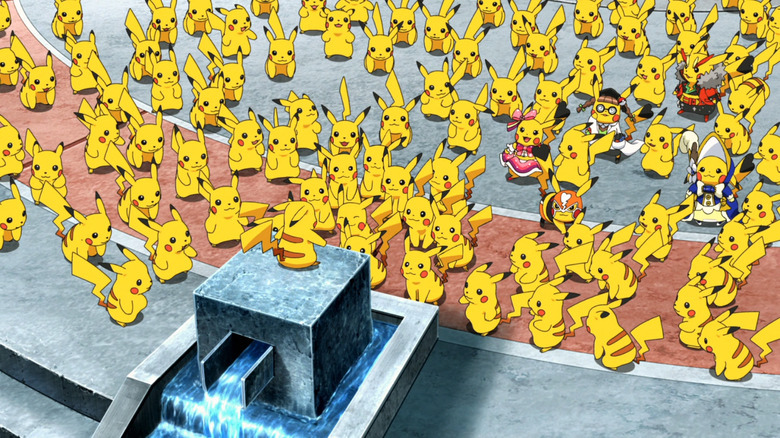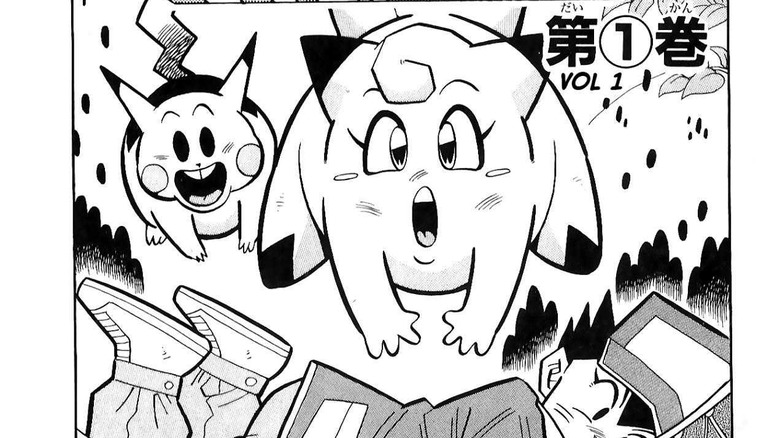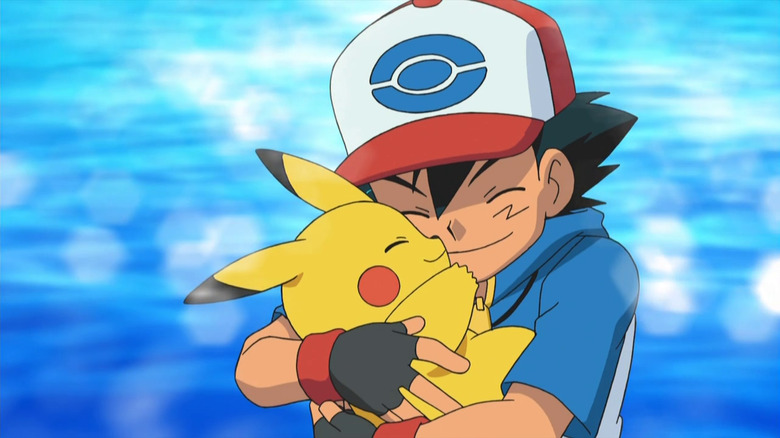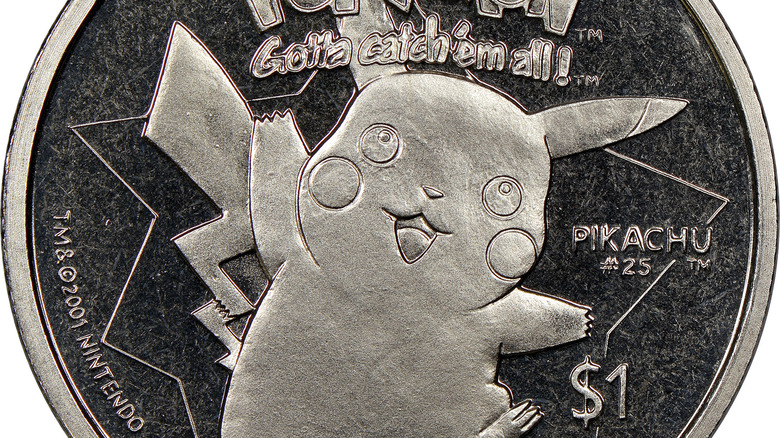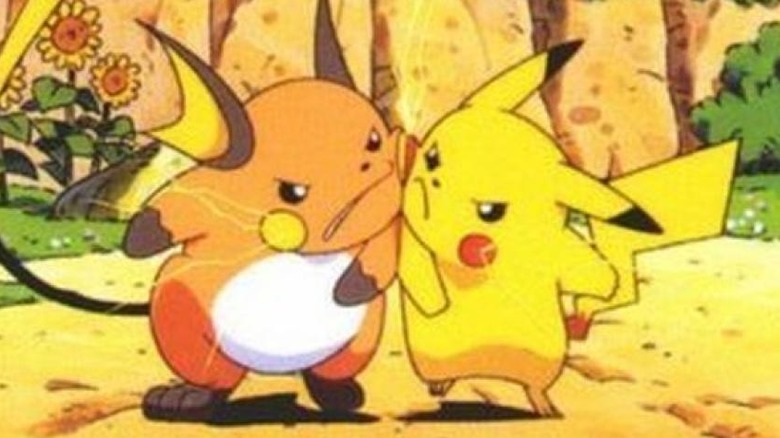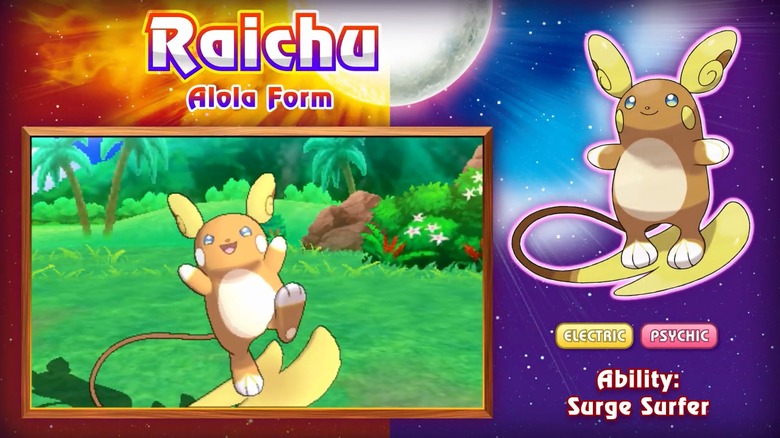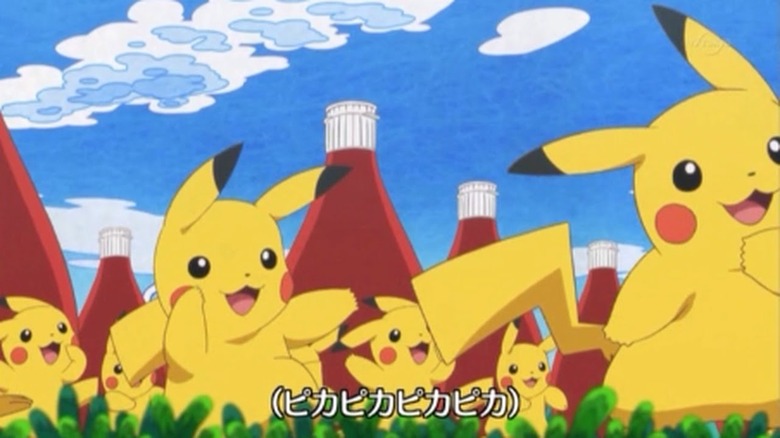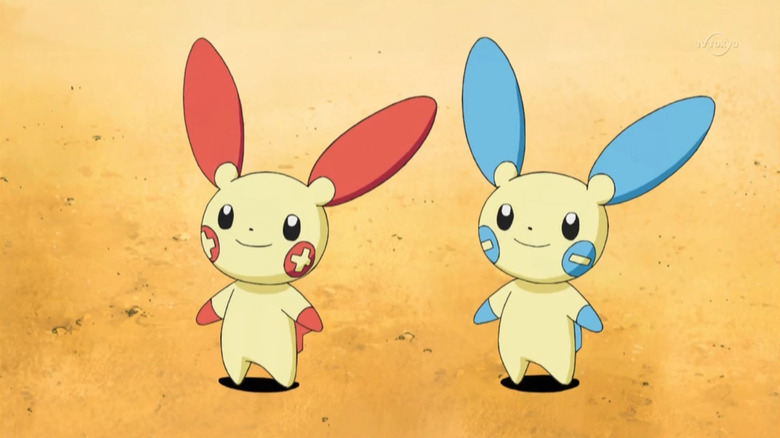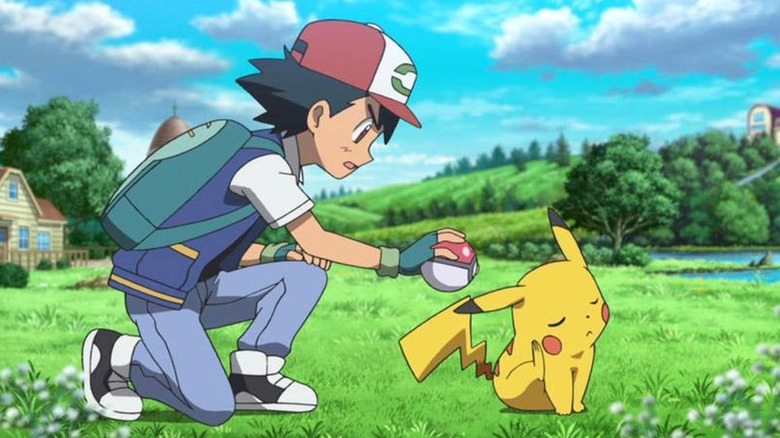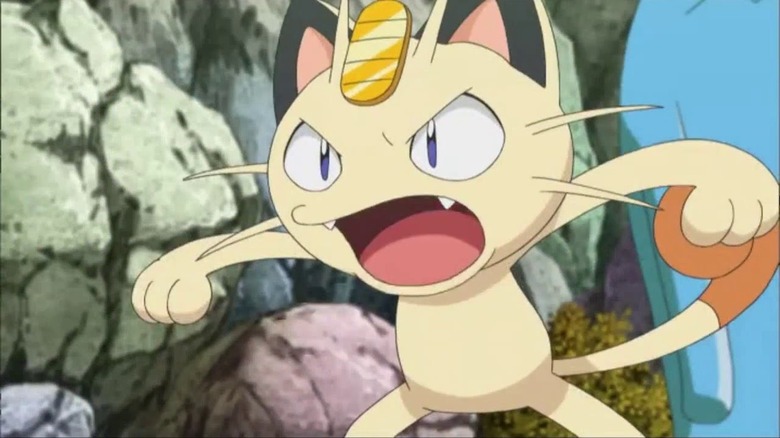Details About Pikachu Only True Fans Noticed
Pikachu is easily one of the world's most recognized, and beloved, characters of all time. In just 20 years this little yellow guy has become an unparalleled superstar. Seriously, who hasn't heard of them? There are plushies, T-shirts, socks, shoes, make-up, and even Pikachu-themed weddings. Pikachu is the face of the whole of the Pokemon series, which is the world's highest grossing media franchise. That's right: Pokemon far surpasses even Disney's grand empire. It's only a matter of time until there's a Pokemon theme park, after all.
Pikachu is an electric-type Pokemon modeled after a mouse with a lightning bolt shaped tail. They can electrocute their enemies while still looking cute, which makes us pretty forgiving about all the scorch marks. Even with such an adorable, recognizable face there's a surprising amount of mystery to Pikachu. We're talking about both the species and Ash's best buddy from the anime as we take a deep dive into all things yellow, zappy, and red-cheeked.
Pikachu isn't number one
Even though Pikachu is the number one most recognized Pokemon, maybe of all time, Pikachu is far from the very first pocket monster. Pikachu ranks in at number 25 in the PokeDex, meaning that designers took their sweet time before getting around to creating what would eventually become their mascot. Which Pokemon actually came first is something of a debate within the Pokemon community. Get ready for some real nerdy theories.
Bulbasaur is number one in the PokeDex, which would mean that it was the first ever Pokemon ... except that it's not. In reality, the first Pokemon ever designed was actually Rhydon, the bipedal kaiju-esque pocket monster, the very first coded into the game. And yet, according to Pokemon lore, Mew is believed to be the ancestor to all Pokemon from which they eventually evolved, and Arceus was the very first living thing, having shaped the whole of the universe like some kind of god. So which Pokemon is the first? It really depends on the context. But we know one thing for sure: it's not Pikachu.
Pikachu loves ... ketchup
Ash's Pikachu is an extraordinary example of the species. He refuses to inhabit a PokeBall, instead opting to ride around on his trainer's shoulder. He is considerably powerful for a Pikachu, able to take on Pokemon the likes of Mega Gyrados. And he loves ketchup. Yes, you read that right. For whatever reason, the anime went out of its way to demonstrate the fact that Pikachu has an infatuation with ketchup.
This legendary love affair started in episode 42 of the anime entitled "Showdown at Dark City." At a restaurant, Pikachu can be seen dumping a concerning amount of ketchup on Ash's omurice, and later the bottle that Pikachu hangs onto so ardently comes in handy. When a Scyther attacks Pikachu, it hits the bottle and is blinded by ketchup, causing it to attack its own trainer instead. Team Rocket also gets deluged in ketchup in this tomato-y episode. Pikachu is reunited with the bottle of his dreams much, much later in the anime, his penchant for the condiment never forgotten.
The tell-tale heart tail
For many Pokemon, there is no discernable difference between males and females of the species. For many years, the same could be said about Pikachu; we knew that Ash's Pikachu was male from the anime, but there was no way of knowing if a randomly caught Pikachu was male or female in game without checking their gender on the game's overlay. However, as sprites became more and more detailed thanks to higher definition screens, subtle additions were added to many first generation sprites in order to tell gender on sight.
When it comes to Pikachu, this difference is not so subtle. Female Pikachu have a distinctive notch in their tail, giving it a heart-shaped appearance, which is frankly adorable. Males have a straight-edged tail, just like Ash's. When female Pikachu evolve into Raichu, their tails aren't heart-shaped, but they're just a bit less pointy than the males of the species.
Pikachu has slimmed down
Pikachu was designed with cuteness in mind: from the big red cheeks to its big, sparkling eyes, there is no denying that Pikachu is seriously adorable. Character designer Atsuko Nishida was tasked by Game Freak co-founder Ken Sugimori to make a Pokemon more cute than the tough monsters that had come about so far. Nishida's original Pikachu design was resembled a daifuku mochi, a round Japanese dessert, with ears sticking out. Game designer Koji Nishino said to make it even cuter, and thus Pikachu was born.
The Pikachu we know and love now is different from the original sprite that graced the original Pokemon games. Over time, especially due to influence from the anime, Pikachu has slimmed down. No longer is Pikachu the ball of electricity it once was: Pikachu has a much more athletic look. Maybe it's because the Pokemon does a lot more than just throw around thunderbolts in the anime. The Pikachu of today runs, jumps, and even dances. That doesn't mean we're not allowed to be nostalgic for the days when Pikachu was a little bit more chubby.
Pikachu can fly?
What's so special about Pikachu that its fuzzy face became the face of Pokemon as a whole? Well there's the fact that despite being an electric-type Pokemon with no wings or fins to speak of, Pikachu can learn the moves Surf and Fly. How do you explain that one, Game Freak?
In Pokemon Yellow, Silver, Gold, and Crystal, Pikachu is not only able to learn Surf, but will appear as a Pikachu on a surfboard if the player chooses to surf on a Pikachu. The surfing Pikachu variant, something of an Easter egg, continued to make appearances in later spin-off games like Pokemon Snap. The flying Pikachu variant uses the power of some multi-colored helium balloons to achieve flight and can be spotted in the opening of Pokemon Yellow. Pikachu apparently gets special privileges when it comes to using these specific moves because it looks so dang cute while doing them. We're willing to overlook this bend in the canon for the sake of seeing Pikachu catch some gnarly waves.
Pikachu destroys public property
Game designer Koji Nishido loved Pikachu so much that he made it one of the rarer Pokemon to find in the original games. These days, Pikachu aren't all that rare, with a 32.5% catch rate; wander into any patch of tall grass in the forest and you're likely to find a Pikachu or two. A tell-tale sign is patches of singed grass; find scorch marks and the smell of ozone, and there's probably a Pikachu nearby. Be cautious, however, dear trainer, because finding a whole group of Pikachu is apparently something of an ill omen.
According to the PokeDex, when Pikachu gather together they can cause lightning storms due to their built up electricity. Forests where Pikachu live are often struck by lightning due to their electrifying inhabitants. When near civilization, Pikachu can cause problems by chewing on telephone poles and destroying electronic equipment. Pikachu's very first appearance in the Pokemon manga showed off the Pokemon's apparent destructive nature: Pikachu was stealing crops and shocking anyone who dared to try to stop him.
Pikachu wasn't meant to be the star
Even though it's hard to think of Pokemon now without Pikachu coming to mind, true fans might know the fun fact that Pikachu wasn't always destined for greatness. Sure, it's a pretty cute creature, but there are other adorable Pokemon to be found in the first generation. Like Clefairy for instance. At one time, Clefairy was almost the face of Pokemon rather than Pikachu.
In one of the many manga that preceded the anime that spread the good word of Pokemon far and wide, Clefairy was the main character's sidekick of choice. This Clefairy was rude, crude, and socially unacceptable, using its gift of speech to make some seriously inappropriate jokes. It had the cute appeal that the creators of the anime were after, but Pikachu was ultimately chosen instead because its design was believed to appeal to both girls and boys. Clefairy reverted back to the magically mysterious Pokemon we love (and wholly prefer over the raunchy manga version) today, while Pikachu took the main stage.
Pikachu's voice lines aren't reused
"Pika-pi! Pika-pika-chu!" What does that mean in Pikachurian? Only voice actress Ikue Otani knows. She has been voicing Pikachu in the anime from the very start, giving everyone's favorite electric mouse its signature squeak. Her audition for Pikachu was actually an accident: she said in an interview with Manga University that she had no idea what a big hit the games were. Once she was cast, however, she came to realize what a big deal Pikachu was, and that it wasn't going to be an average role.
Pikachu's lines are never repeated. For each episode, Otani does each individual line, always keeping in mind what he might be thinking or feeling. "Because Pikachu can't say anything other than its name, the audience has to think about what the 'Pikachu' noises mean and learn to understand the character," she said. "So for example, if Pikachu wants to say something like 'Yatte yaroze' ('Let's do it!'), I would say 'Pika-pika-chu!'" At the start, Otani was told that Pikachu would gradually learn how to speak, but that idea was scrapped just a few months later. She instead adjusted for a long career of saying variations of "Pikachu!"
Paying with Pikachu
There is Pokemon merch of just about everything, from official merch from the Pokemon Center itself to all the fanmade goods flooding sites like Etsy. You can get Pikachu's face on everything and anything: shirts, underwear, cookware, umbrellas, and even legal tender. Money. That can be exchanged in stores. If you live in Niue, that is.
Niue is a little slice of nerdy paradise in the Pacific, 1,500 miles away from New Zealand. One of the smallest countries in the world, the Polynesian island boasts less than two thousand inhabitants, but makes up for that with free, island-wide WiFi and a Pikachu fun fact. In 2001, Niue made international waves by slapping Pikachu's face onto its official currency. The series of $1 coins featured Pikachu, Charmander, Squirtle, Bulbasaur, and Meowth. Today, they're worth way more than just a New Zealand dollar a piece.
Gorochu: the big chu that never was
In recent years, one of Pokemon's best kept secrets was unveiled, much to the delight of fans. Pikachu is so popular that sometimes people forget about poor Raichu, its evolved form. Long, long forgotten, however, is the fact that at one point, Pikachu was going to have a third evolution: the monsterous, horned Gorochu.
According to a leak of unused generation one Pokemon designs taken from assets from an early build of Pokemon Red and Green obtained by a collector, Raichu would evolve into Gorochu, which had horns and fangs, and was designed by Pikachu's original creator Atsuko Nishida. However, Gorochu was ultimately removed due to issues of "balance," according to game designer Ken Sugimori. This, and the fact that the unused sprite is blurry at best, hasn't stopped Pokemon fans from imagining what Gorochu would look like, should it have survived to see the light of day. Mostly, the popular idea seems to be that Gorochu would be a big, red version of Raichu with horns, floppy ears, and some not-so-threatening fangs. Anything that comes from Pikachu has to be cute, after all.
A blue-eyed surfing pikachu
When Pokemon Sun and Moon were announced, the games came jam-packed with all new content and a big shake-up to the Pokemon canon: Alolan Forms. According to the games, the Alolan region was such a unique environment that Pokemon usually native to Kanto adapted differently. Some became dark types, like Meowth, while others switch from fire to ice, like Vulpix. Pikachu in the Alola region evolve into Alolan Raichu, a psychic/electric type that floats on its tail, like a surfer.
Fans immediately recognized that this adorable design was likely inspired by the age old-trope of the surfing Pikachu, stopping just short of making the Alolan Raichu a water type. Alolan Raichu has a tan worthy of any beach bum and stunning blue eyes the color of a calm ocean. Alolan Raichu's blue eyes might be inspired by a certain surfing Pikachu from the anime named Puka, you know, like the shell. Puka appears in episode 67 of the anime entitled "The Legend of the Surfing Pikachu," his blue eyes glowing whenever a big wave is about to come in.
It's all in the name
Pokemon names are often puns. There are obvious ones, like Meowth and Magikarp. There are others that take a little more digging like Trevenant (tree and revenant) or Moltres (molten and tres, because it is the third legendary bird). And then there are still others that won't really make any sense at all unless you're familiar with the Japanese language. Unlike many Pokemon, Pikachu's name didn't change when it was localized for an English-speaking audience. Neither was Raichu, and we'll guess that Gorochu wouldn't have either, had Pikachu's third evolution been published. This is because the puns behind their names are just too fitting to improve upon.
Pikachu's name comes from the Japanese onomatopoeia word "pika-pika," which is used to describe glitter. "Chu" is the word used to describe the sound that mice make, the same way English-speakers say that dogs go "woof." So Pikachu's name roughly translates into glitter (like the sparkle of lightning) plus mouse sounds. Rai means thunder in Japanese, so Raichu is thunder plus mouse sounds. Finally, Gorochu goes the onomatopoeia route and combines "goro," the sound of rumbling thunder, with mouse sounds. Again, so fitting that the localization team didn't dare deviate from the original.
There's a whole Pikachu family
Through his adorable antics in the anime and universal appeal, Pikachu became the Pokemon Company's mascot, the face of the whole franchise. That didn't stop designers from trying — pardon the phrasing — to get lightning to strike twice. Eagle- (or should we say Braviary)-eyed fans will have noticed that with each generation, there's a new cute contender for attention that looks a whole lot like Pikachu.
The electric rodent, or Pikachu family, gets a new member with each generation of Pokemon. First came Pikachu's pre-evolved or baby form, Pichu, which quickly gained attention. The third generation introduced dynamic duo Plusle and Minun who look like they could be close cousins. Next was electric squirrel Pachirisu, complete with electrifying cheeks, and then flying squirrel Emolga in generation five. Gen six saw the addition of Dedenne, a kind of mini-Raichu, followed by gen seven's mousy Togedemaru. Pokemon Sword and Shield feature the electric/dark type Morpeko with its pink cheeks and insatiable appetite.
Why won't Pikachu stay in his PokeBall?
Ash's Pikachu from the anime gets special treatment when it comes to Pokemon. He's obviously his trainer's favorite, even if Ash claims that he doesn't play favorites. Pikachu is part of the gang, always out of his PokeBall and making his opinion known. But why is Pikachu so stubborn when it comes to getting in his PokeBall? Did he have a bad experience? Is his PokeBall broken somehow? What is inside a PokeBall, anyway?
The one thing we for sure know about the inner workings of PokeBalls is that they serve to protect Pokemon from further damage. Trainers aren't forced to lug around their injured Pokemon, they can just return them to their PokeBall and then heal them at a Pokemon Center. Except in the case of Pikachu. The movie Pokémon: I Choose You! retells Ash and Pikachu's story with one extra addition: the reason why, even when facing death, Pikachu won't return to his PokeBall. The movie was panned because of the jarring moment that Pikachu suddenly starts speaking full-fledged English and tells Ash, "It's because I always want to be with you."
Uh. Okay.
Pikachu vs Meowth: destined to be enemies
Meowth is a talking Pokemon, but he's one of the lone exceptions to the rule that Pokemon can only say their name, over and over again. Alongside Pikachu, he's one of the more human-like pocket monsters, with his own agendas and preferences and complicated relationships with his "trainers." (Really, Jesse and James are more like co-workers.)
The anime pits Pikachu and Meowth as enemies, constantly playing a game of ... well, cat and mouse. It turns out that Pikachu and Meowth were destined to be at odds, and it's not just because they're on opposite teams. Taking a look into the PokeDex, we know that Pikachu is number 25, whereas Meowth is flipped: he's number 52. Destiny, fate, game designers, whatever you want to call it: a higher power deemed that Meowth and Pikachu would be arch rivals and enemies in the Pokemon series.

